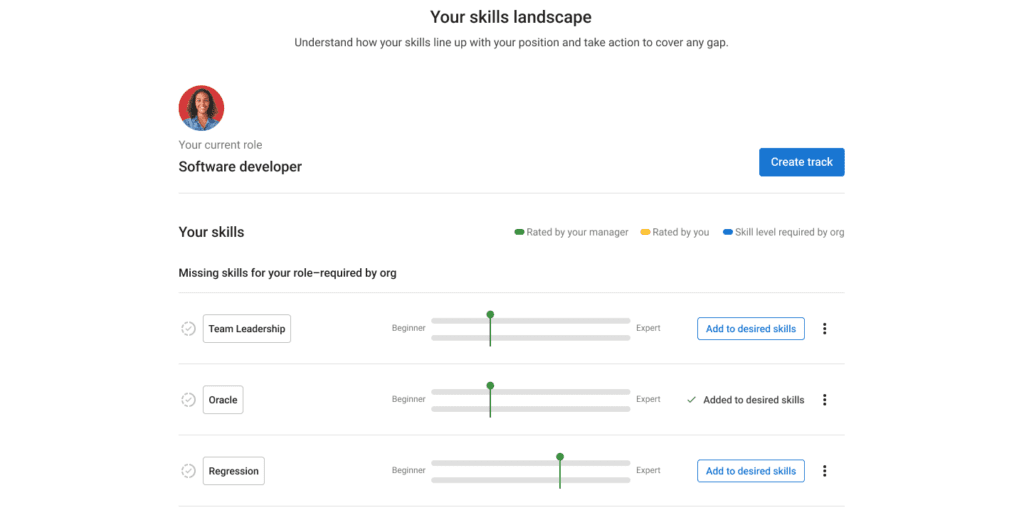How skills-focused career development maximizes employee potential
Put skills at the center of career progression with our newest offering, Skills Landscape

Most leaders recognize that there’s one common denominator that every agile organization shares—a skills-based strategy.
Although many businesses understand the importance of skill-building, very few have the tools and systems in place to put these capabilities in context. Most people don’t know what skills they must hone for their roles, and all too often the capabilities their employer expects them to have don’t align with what an employee thinks makes them qualified for the job.
As a result, some workers end up wasting their time on upskilling and reskilling opportunities that don’t make sense for their career development goals. Instead of letting knowledge gaps widen, businesses need a tool that gives everyone a clear picture of the skills they need to develop to take their careers to the next level—which is where our new Skills Landscape offering comes into play.
How skills-based organizations approach career development
Skills-based strategies have emerged as the optimal approach for the new world of work. Organizations that prioritize building critical competencies reap several game-changing benefits, including greater agility, improved engagement and retention rates, and better cross-functional collaboration.
What sets skills-based organizations apart is their ability to taskify projects, shifting the unit of work from jobs to skills. This change in perspective allows talent to flow freely across the organization, in turn empowering employees to take on new projects, gigs, and roles based on the knowledge they have and the skills they’re looking to build.
Activating a skills-based strategy requires organizations to rethink their approach to career development. Rather than focusing solely on years of experience and adhering to traditional, vertical progressions, career development at a skills-based organization is rooted in building new competencies.
Employees are empowered to grow their careers in all directions and take on projects and roles that will help them gain the skills they need to achieve their career goals. To turn their professional visions into realities, workers must see eye to eye with their employers on skills needs and align on what competencies must be prioritized to advance their careers.
Introducing Skills Landscape, a career development tool for the skills-based workforce
Despite the importance of skills-based career development, there aren’t many systems designed to ensure employees and managers are aligned on required capabilities. In some organizations, employees are left to guess which skills they should be prioritizing to excel in their current roles and reach their long-term goals. But when workers choose wrong, countless hours and dollars go to waste—not to mention serious dips in engagement and morale.
To prevent misalignments from holding people back, we’re introducing Skills Landscape. This tool enables a granular skill-level understanding of an employee’s current role so that workers and their managers stay on the same page. Skills Landscape offers visibility and action against existing and missing skills as defined by the organization and based on market data. The offering goes one step further by allowing employees to create a career track that will suggest opportunities to bridge skill gaps.
3 ways to enhance career development with Skills Landscape
Skills Landscape eliminates the guesswork associated with career development so employees can focus on what matters most—building the skills needed to take their progression to the next level. Here’s how our offering promotes skills-based career development:
#1. Ensure upskilling and reskilling are purpose-led
At skills-based organizations, all L&D opportunities must connect back to the competencies employees need to build to achieve their career goals. Rather than settling for learning for the sake of learning, every project, gig, and training that an employee participates in should take them one step closer to reaching their next milestone. With Skills Landscape, employees and managers can align on the reskilling and upskilling initiatives that should be prioritized, based on existing knowledge gaps and personal career development goals.
#2. See how your skills requirements stack up
Since skills are the foundation of agile organizations, businesses can’t afford to lower their standards or settle for subpar requirements when it comes to workforce capabilities. Instead, leaders must keep a finger on the pulse and understand how their competitors are approaching upskilling and reskilling so they can stay one step ahead of them.
By harnessing data from proprietary sources, such as market information and customer aggregates, Skills Landscape sheds light on the competencies that leaders should require for various roles. When combined with Workforce Intelligence, businesses get skills requirements insights powered by a combination of their custom skills data and Gloat sources, creating a full picture of what capabilities must be prioritized.
#3. Zoom in on skills proficiency
An employee who managed one project doesn’t have the same level of expertise as their colleague who has overseen dozens. But oftentimes, it’s challenging for leaders to gain insight into just how proficient employees are when it comes to specific skills.
With Skills Landscape, workers can rate their proficiency levels, allowing them to understand where they are right now compared to their role’s desired knowledge level. Managers can also take an active role in developing their employees by assessing their proficiency levels to ensure workers have the knowledge needed to excel in their roles.
To learn more about what it takes to empower employees to take charge of their career development, check out how workforce agility platforms can help you grow and develop your people.







